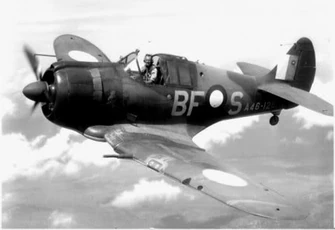
The CAC Boomerang was a World War II fighter aircraft designed and manufactured in Australia between 1942 and 1945. The Commonwealth Aircraft Corporation produced Boomerangs under the production contract numbers CA-12, CA-13, CA-14 and CA-19, with aircraft supplied under each subsequent contract incorporating modifications and improvements. The Boomerang is significant as the first combat aircraft designed and built in Australia.
Development[]
Lawrence Wackett, general manager and former chief designer of CAC, recruited designer Fred David, an Austrian Jew who had recently arrived in Australia as a refugee. As David was technically an enemy alien, he was interned by Australian immigration officials. He was well-suited to the CAC project, since he had previously worked for Heinkel in pre-Nazi Germany, as well as Mitsubishi and Aichi in Japan. As a result, David had an excellent understanding of advanced fighter designs, including the Mitsubishi A6M ("Zero") (used by the Imperial Japanese Naval Air Service) and the Heinkel He 112 (a contemporary of the Messerschmitt Bf 109 and used in small numbers by Axis air forces in Europe). Design work began on 21 December 1941, at the CAC factory in Fishermans Bend, Melbourne.
The Boomerang was a small fighter, designed with an emphasis on manoeuvrability. It had an overall length of just 7.7 metres (25.5 ft) and an 11 m (36 ft) wingspan. Although the original intention had been to use as many Wirraway components as possible, the final design was quite different, with shorter wings, a shorter, wood-sheathed, aluminium-framed fuselage, increased strength for combat stresses and a new centre section.
On 2 February 1942, before the debut flight of the Boomerang's prototype, the RAAF ordered 105 CA-12 (Mark I) variants. The prototype commenced test flights on 29 May, with pilots Ken Frewin (CAC) and John Harper (RAAF). On 15 July, No. 1 Aircraft Depot RAAF received A46-1 (bu. no. 824) from CAC. Comparison flight tests were undertaken by 1 AD, against a Brewster Buffalo (A51-6) that had been lightened and re-weighted to approximate the flight characteristics of a Zero, as well as a P-40E (A29-129) and a P-400 (BW127). It was found that the Boomerang was faster in level flight than the "Zero", although the Buffalo out-manoeuvred it. The Boomerang was superior in armament, with two 20 mm cannon and four .303 calibre (7.7 mm) machine guns, all mounted in the short, thick wings. Its pilots were better protected, with generous armour plating, than Japanese fighter pilots. While the CA-12 was lively at low level, its performance fell away rapidly above altitudes of 15,000 ft (4,600 m), and its maximum speed of 265 knots (490 km/h) was not sufficient to make it an effective counter to Japanese fighters like the Zero and the Imperial Japanese Army Air Force's Nakajima Ki 43 ("Oscar"). Similarly, the best European fighters were reaching almost 350 knots (650 km/h), and even relatively sluggish fighters like the Wildcat and the Kittyhawk (which would become the main fighter used by the RAAF during the war) were much faster than the Boomerang.
As test and trial flights commenced, CAC had already begun work on a new variant, the CA-14, to address the Boomerang's deficiencies in speed, climb and ceiling. The CA-14 was designed around an order for 145 U.S.-built, 1,700 hp (1,268 kW) Wright Cyclone R-2600 engines. However, the Wright engines ordered were not delivered as scheduled, and in mid-1942 Wackett authorised use of the 1,850 hp (1,380 kW) Pratt & Whitney R-2800, which was available from the CAC factory in Lidcombe. However, the significantly greater weight of this powerplant led to an unacceptable risk of undercarriage failure. (The R-2800 engine would later be the basis of design work on the Boomerang's successor, the CAC CA-15, also known as the "Kangaroo".) CAC eventually returned to the Twin Wasp, to which it added a General Electric B-2 turbo-supercharger mounted inside the rear part of the fuselage, new propellor gear, a geared cooling fan (influenced by intelligence reports from Europe regarding captured German BMW 801 twin-row radial engines, which were used by the Focke-Wulf Fw 190A) and a larger, squared-off tailfin and rudder. By July 1943, the significantly re-worked CA-14 prototype, now known as the CA-14A, had a top speed that was 25–30% better than the CA-12, and an operational ceiling 4,000 ft (1,200 m) higher.
Testing of later Boomerang variants found that they compared favourably with the Spitfire Mk V and early Thunderbolts and Mustangs. By this time, however, British-built Spitfires had filled the interceptor role and Mustangs had been ordered, to fill the bomber escort, air superiority and close air support roles. Consequently, production Boomerangs were never fitted with superchargers.

